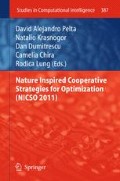Abstract
An improved unsupervised bio-inspired clustering model is introduced. The main goal is to involve a correlation between properties of objects and some bio-inspired factors. The statistical classification biological model is based on the chemical recognition system of ants. Ants are able to create groups discriminating between nest-mates and intruders based on similar odor. Comparative analysis are performed on real data sets.
Access this chapter
Tax calculation will be finalised at checkout
Purchases are for personal use only
Preview
Unable to display preview. Download preview PDF.
References
Blake, C.L., Merz, C.J.: Machine learning repository (1998)
Colorni, A., Dorigo, M., Maniezzo, V.: Distributed Optimization by Ant Colonies. In: Proceedings of the First European Conference on Artificial Life, pp. 134–142. Elsevier Publishing, Amsterdam (1991)
Golden, B.L., Assad, A.A.: A decision-theoretic framework for comparing heuristics. European J. of Oper. Res. 18, 167–171 (1984)
Holldobler, B., Wilson, E.O.: The Ants. Springer, Heidelberg (1990)
Jain, A.K., Dubes, R.C.: Square-Error Clustering method. In: Algorithms for clustering data. Prentice Hall Advanced References series, pp. 96–101 (1988)
Kuntz, P., Snyers, D.: Emergent Colonization and Graph Partitioning. In: Proceedings of the Third Int. Conf. on Simulation of Adaptive Behaviour, pp. 494–500. MIT Press, Cambridge (1994)
Labroche, N., Monmarché, N., Venturini, G.: A new clustering algorithm based on the chemical recognition system of ants. In: Proceedings of the European Conference of Artificial Intelligence, pp. 345–349. IOS Press, Amsterdam (2002)
Labroche, N., Monmarché, N., Lenoir, A., Venturini, G.: Modélisation du système de reconnaissance chimique des fourmis. Rapport interne, Lab. d’Informatique de l’Universite du Tours (2002)
Labroche, N., Monmarché, N., Venturini, G.: Web session clustering with artificial ants colonies. In: Proceedings of Conference WWW 2003, Budapest, Hungary (2003)
Monmarché, N.: Algorithmes de fourmis artificielles: applications à la classification et à l’optimisation. Thèse de doctorat, Lab. d’Informatique de l’Universite de Tours (2000)
Monmarché, N., Slimane, M., Venturini, G.: On Improving Clustering in Numerical Databases with Artificial Ants. LNCS (LNAI), pp. 626–635 (1999)
Pintea, C.-M.: A clustering model based on ant-system. In: Proceeding of Int. Conf. of Applied Mathematics (ICAM5), p. 38 (2006)
Author information
Authors and Affiliations
Editor information
Editors and Affiliations
Rights and permissions
Copyright information
© 2011 Springer-Verlag Berlin Heidelberg
About this chapter
Cite this chapter
Pintea, CM., Sabau, S.V. (2011). Correlations Involved in a Bio-inspired Classification Technique. In: Pelta, D.A., Krasnogor, N., Dumitrescu, D., Chira, C., Lung, R. (eds) Nature Inspired Cooperative Strategies for Optimization (NICSO 2011). Studies in Computational Intelligence, vol 387. Springer, Berlin, Heidelberg. https://doi.org/10.1007/978-3-642-24094-2_17
Download citation
DOI: https://doi.org/10.1007/978-3-642-24094-2_17
Publisher Name: Springer, Berlin, Heidelberg
Print ISBN: 978-3-642-24093-5
Online ISBN: 978-3-642-24094-2
eBook Packages: EngineeringEngineering (R0)

